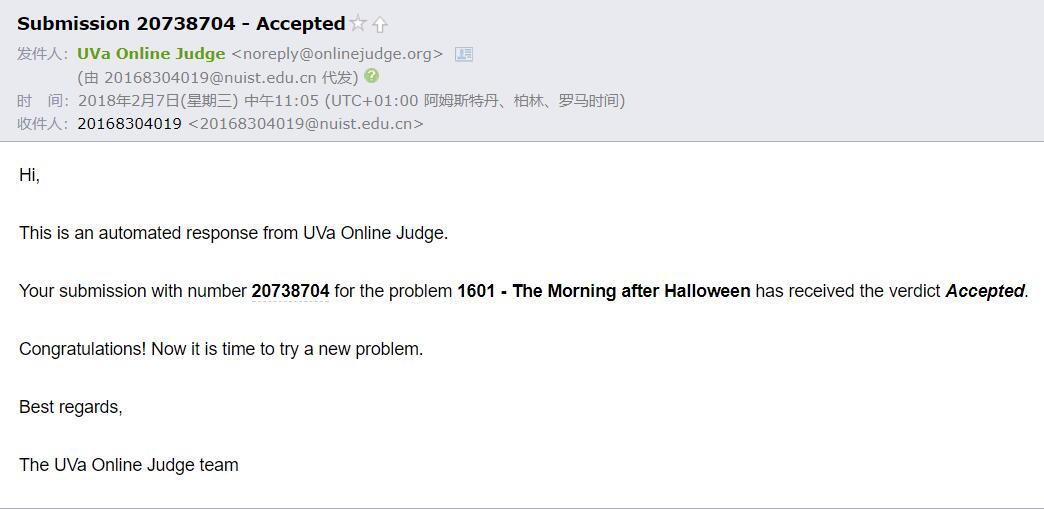【算法竞赛入门经典】6.5[图的BFS] 例题6-20 UVa1599 (2)
2018-02-07 18:08
429 查看
【算法竞赛入门经典】7.5 路径寻找问题 例题7-9 UVa1601
算法竞赛入门经典75 路径寻找问题 例题7-9 UVa1601双向BFS
分析
本题储存结构
样例实现代码
结果
之前我写了一个单向BFS+可访问图优化的任务,现在更新一个双向BFS的操作。
双向BFS
双向BFS就是从起点终点同时开始进行BFS,直到找到对方为止。这样的好处是避免层次过大的情况下,单向BFS过快造成过量数据,导致搜索变满。而双向BFS就很好的优化了这一点。
分析。
注意:双向BFS的情况下,结束的条件变为找到对方!!!!!这一点由单向BFS改为双向BFS的时候很容易出错。
本题储存结构
与单向BFS时基本相同。只不过不能为了省空间用dis数组是否为-1判断是否访问并且同时储存是否访问了,因为要区别正反的访问标号。所以,除了原dis数组,需要一个新的vis数组,0表示没访问,1表示正向访问,2表示反向访问。
样例实现代码
#include<iostream>
#include<queue>
#include<cstring>
#define maxs 20
#define maxn 150
using namespace std;
int s[3], d[3];
int nex[maxn], G[maxn][5];
int dx[] = { -1,1,0,0,0 };
int dy[] = { 0,0,-1,1,0 };
int dis[maxn][maxn][maxn];
int vis[maxn][maxn][maxn];
int getID(int a, int b, int c) {
return ((a << 16) | (b << 8) | c);
}
bool conflict(int a, int b, int a2, int b2) {
if (a2 == b2 || (a == b2) && (b == a2))
return true;
return false;
}
int dfs() {
memset(dis, 0, sizeof(dis));
memset(vis, 0, sizeof(vis));
int pos = getID(s[0], s[1], s[2]);
int bpos=getID(d[0],d[1],d[2]);
queue<int>q;
queue<int>p;
q.push(pos);
p.push(bpos);
dis[s[0]][s[1]][s[2]] = 0;
dis[d[0]][d[1]][d[2]] = 1;
while (!q.empty()||p.empty()) {
int funq=q.size();
int funp=p.size();
while(funq--){
int u = q.front();
q.pop();
int a = (u >> 16) & 0xff, b = (u >> 8) & 0xff, c = u & 0xff;
for (int i = 0; i < nex[a]; i++) {
int a2 = G[a][i];
for (int j = 0; j < nex[b]; j++) {
int b2 = G[b][j];
if (conflict(a, b, a2, b2))
continue;
for (int k = 0; k < nex[c]; k++) {
int c2 = G[c][k];
if (conflict(a, c, a2, c2) | conflict(b, c, b2, c2))
continue;
if (vis[a2][b2][c2]==0) {
dis[a2][b2][c2] = dis[a][b][c] + 1;
vis[a2][b2][c2] = 1;
q.push(getID(a2, b2, c2));
}
else if(vis[a2][b2][c2]==2)
return dis[a][b][c]+dis[a2][b2][c2];
}
}
}
}
while(funp--){
int u = p.front();
p.pop();
int a = (u >> 16) & 0xff, b = (u >> 8) & 0xff, c = u & 0xff;
for (int i = 0; i < nex[a]; i++) {
int a2 = G[a][i];
for (int j = 0; j < nex[b]; j++) {
int b2 = G[b][j];
if (conflict(a, b, a2, b2))
continue;
for (int k = 0; k < nex[c]; k++) {
int c2 = G[c][k];
if (conflict(a, c, a2, c2) | conflict(b, c, b2, c2))
continue;
if (vis[a2][b2][c2]==0) {
dis[a2][b2][c2] = dis[a][b][c] + 1;
vis[a2][b2][c2] = 2;
p.push(getID(a2, b2, c2));
}
else if(vis[a2][b2][c2]==1)
return dis[a][b][c]+dis[a2][b2][c2];
}
}
}
}
}
return -1;
}
int main() {
int w, h, n;
while (cin >> w >> h >> n) {
if(n==0)
break;
getchar();
char maze[20][20];
for (int i = 0; i < h; i++)
fgets(maze[i], 20, stdin);
int cnt = 0, x[maxn], y[maxn], ID[maxn][maxn];
for(int i=0;i<h;i++)
for(int j=0;j<w;j++)
if (maze[i][j] != '#') {
ID[i][j] = cnt;
x[cnt] = i;
y[cnt] = j;
if (islower(maze[i][j])) {
s[maze[i][j] - 'a'] = cnt;
}
if (isupper(maze[i][j])) {
d[maze[i][j] - 'A'] = cnt;
}
cnt++;
}
for (int i = 0; i < cnt; i++) {
nex[i] = 0;
int nowx, nowy;
for (int j = 0; j < 5; j++) {
nowx = x[i] + dx[j];
nowy = y[i] + dy[j];
if (nowx < 0 || nowx >= h || nowy < 0 || nowy >= w)
continue;
if (maze[nowx][nowy] != '#') {
G[i][nex[i]] = ID[nowx][nowy];
nex[i]++;
}
}
}
if (n <= 2) {
nex[cnt] = 1;
G[cnt][0] = cnt;
s[2] = d[2] = cnt++;
}
if (n <= 1) {
nex[cnt] = 1;
G[cnt][0] = cnt;
s[1] = d[1] = cnt++;
}
cout << dfs() << endl;
}
return 0;
}结果

附两种结果比较:

相关文章推荐
- 【算法竞赛入门经典】6.5[图的BFS] 例题6-20 UVa1599
- 【算法竞赛入门经典】6.4.2用BFS求最短路 例题6-14 UVa816
- 【算法竞赛入门经典】6.5[图的概念和拓扑序] 例题6-21 UVa506
- 算法竞赛入门经典第五章例题5-7 Ugly Numbers UVA - 136
- 【算法竞赛入门经典】7.5 路径寻找问题 例题7-9 UVa1601(1)
- 【算法竞赛入门经典】树形DP的状态转移方程优化 例题9-14 UVa1218
- 【算法竞赛入门经典】DAG上的动态规划 例题9-2 UVa437
- 算法竞赛入门经典第五章例题5-5 The SetStack Computer UVA - 12096
- 算法竞赛入门经典第六章例题6-7 Trees on the level UVA - 122
- 【算法竞赛入门经典】回溯法与最优性剪枝条 例题7-6 UVa140
- 算法竞赛入门经典 第二版 例题11-4 电话圈 Calling Circles uva247
- UVa 133 算法竞赛入门经典4-3例题(约瑟夫环类型)
- 【算法竞赛入门经典】多阶段决策问题 例题9-5 UVa12563
- 【算法竞赛入门经典】多阶段决策问题 例题9-4 UVa116
- 【算法竞赛入门经典】动态规划初步 例题9-7 UVa11584
- 【算法竞赛入门经典】类LCS动态规划;指标函数分解 例题9-7 UVa1625
- 【算法竞赛入门经典】7.7 回溯法求连通块 例题7-14 UVa1602
- 算法竞赛入门经典第四章例题4-2 Hangman Judge UVA - 489
- 【算法竞赛入门经典】动态规划初步 例题9-6 UVa11400
- 算法竞赛入门经典第六章例题6-3 Matrix Chain Multiplication UVA - 442
